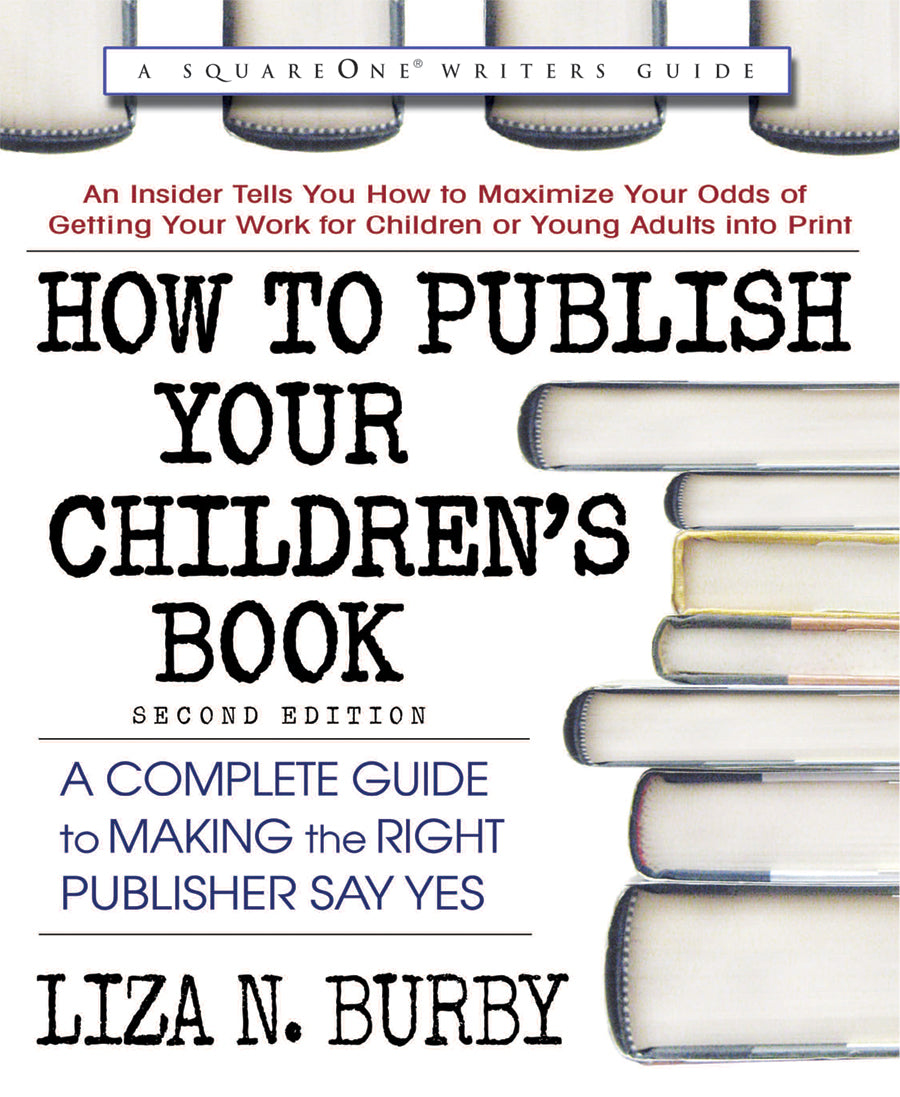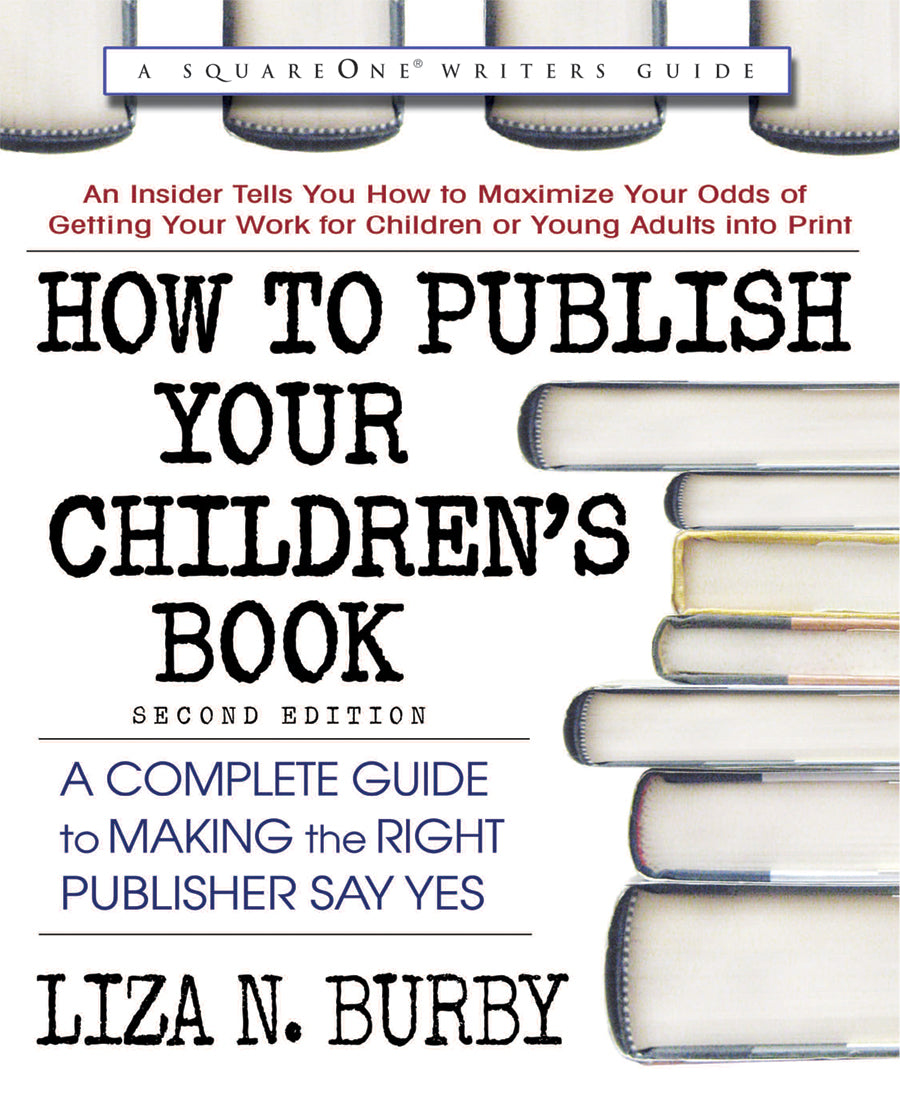It is the place where wizards live, forests are enchanted, and things are often not what they seem. It is also the home of editors, agents, marketers, and art directors. It is the world of children’s book publishing. Until the first edition of this book was released, it was one of the most confusing places for hopeful writers to navigate as well. Now, in response to a rapidly changing industry, award-winning writer Liza N. Burby has revised and updated this complete guide to making the right children’s book publisher say yes to your book for children or young adults.
This edition of How to Publish Your Children’s Book begins by helping you define your book’s category, audience, and marketplace so that you know exactly where your book “fits in.” You are then taught how to choose the best publishing companies for your book proposal, as well as coached in how to write a winning submission package. Then the Square One System tells you exactly how to submit your package so that you optimize your chance of success while minimizing your time, cost, and effort. Also included is a special section on contracts that will turn legalese into plain English, allowing you to be a savvy player in the publishing game. Most important, this book will help you avoid the most common errors that so often prevent writers from reaching their goal. Throughout each chapter, you will gain valuable insight into the typical thought processes of children’s book editors, agents, and publishers, as well as practical advice from popular children’s authors such as Jane Yolen and Johanna Hurwitz.
Whether you’re just thinking about writing a YA or children’s book, or are already a published author, you’re sure to find How to Publish Your Children’s Book a solid reference guide you can use time and time again.
Liza N. Burby received her undergraduate degree in journalism from St. John’s University in Jamaica, New York. She is an award-winning author of thirty-seven nonfiction history, science, health, and social issue books for elementary through high school readers, and three books for adults. She is also a noted journalist whose articles frequently appear in national magazines and newspapers, including Better Homes & Gardens, Newsday, and the New York Times. A former editor of children's, art, health, and educational books, Ms. Burby is currently an editor of various magazine and newspaper projects, and a senior adjunct professor of journalism at Adelphi University in Garden City, New York.
Contents
Acknowledgments
Preface
A Note on Gender
1. An Introduction
2. Where Does Your Book Fit In?
3. The Business of Children’s Book Publishing
4. Choosing the Right Publisher
5. Preparing the Package
6. Using the Square One System
7. The Deal
8. When It Doesn’t Happen
Conclusion
Glossary
Resource List
Index
"Whether you are aspiring to write a YA or children's book, or are already a published children's book author, the novice and the seasoned professional will find How to Publish Your Children's Book a solid reference guide that will prove to be an invaluable, practical, and thoroughly 'user friendly' instructional reference, making it especially and unreservedly recommended for personal, professional, community, college, and academic library Writing/Publishing instructional reference and resource collections."
Acknowledgments
Special thanks to my family, Steve, Danielle, and Laura, without whose patience and love I would never meet a deadline. Also, to Rudy Shur, my publisher, for giving me the opportunity to revise this guide; to Joanne Abrams and Michael Weatherhead, my editors, for their insightful guidance; and to my agent, Grace Freedson, for making the match.
Numerous people answered my many questions while writing this book. They include authors Louise Borden, Marcia Byalick, Neil Gaiman, Johanna Hurwitz, Gail Carson Levine, Gae Polisner, Ann Rinaldi, Veronica Roth, and Hans Wilhelm; editors Susan Eddy at Mondo Publishing, Amy Griffen of Orchard Books, Rahel Lerner of Viz LLC, Hannah Ehrlich of Lee & Low, Laura Hornik and Lori Benton of Henry Holt, Phoebe Yeh of Harper, and Jodi Kreitzman of Knopf Delacourte Dell; as well as agents Danielle Burby of Nelson Literary Agency, Jenne Dunham of Dunham Agency, Tracey Adams of Adams Literary, Brianne Johnson of Writer’s House, and Tema Siegel. I would also like to thank children’s book editor Jill Jarnow for her careful review of the original book. I also received wonderful help from children’s librarians Janet Scherer and Lynn Vitters of the South Huntington Library.
Finally, I thank Laura Backes and Jon Bard for allowing me to draw from “In Their Own Words: The Best of CBI’s Interviews,” and reprint the words of authors Elizabeth-Ann Sachs, Jane Yolen, Dandi Daley Mackall, and Kathleen Duey.
Preface
How many times have you felt just the tiniest bit envious of Harry Potter author J.K. Rowling, even as you read her words with admiration? How about the award-winning picture book author Mo Willems? How many times have you told yourself that you, too, have a tale or nonfiction topic to share with children? Surely you’ve asked yourself: How can I get my work published?
It takes a lot of effort to turn your written words into a published book, but it’s also an enjoyable process. Whether you’re describing the life of the president of the United States or telling the tale of a magical land, writing for children is fun. After all, how many of us aren’t writing just for our young readers, but also for the pure pleasure of immersing ourselves in the world of children? That’s why we owe our words the dedication it takes to see them in print. Nevertheless, in the process of pursuing a publishing contract, most of us can use some help to get the work from our computers to the bookstore and library shelves.
I’m the author of biographies, history, science, health, and social issue books for readers from elementary through high school. In fact, I’ve seen my name on the cover of thirty-seven children’s books. I’ve also been a book editor. I know the most common mistakes writers make, the ones that get their work rejected. And I know what makes editors reach for the phone with excitement to say, “I want to publish your book.”
This second edition of How to Publish Your Children’s Book offers practical information based on my own experience, as well as advice from literary agents, editors, publishers, and published authors. In this updated version, in addition to telling you all the ways the industry continues to evolve, I’ve included brand new sections that offer information on narrative nonfiction, additional advice from published children’s authors, backgrounds of books that have been game changers, and details on boutique publishers, e-mail submissions, fan fiction, and e-publishing. The book also has a completely revised resource section of books, periodicals, organizations, and websites for your reference.
Throughout these pages, you’ll find many helpful hints that will give you an extra edge as you pursue your first publishing contract. For instance, the best way to stay at the top of your game, so to speak, is to read children’s books. How is that for agreeable “homework”?
Your dream of being a published children’s book author can come true, and this book can help you make it happen. In Chapter 1, you’ll be introduced to the world of children’s book publishing, and to the Square One System for getting your children’s book into print. This chapter also presents the first of many rules that you must learn and follow to get your book published. These rules will pop up now and then throughout the book, helping to steer you towards your goal.
One crucial difference between success and failure is having a clear understanding of where your book fits in the market. Chapter 2 therefore explains what book categories are, and introduces theSquare One Book Classification System—a system that will help you easily and accurately identify the category in which your book belongs. This important chapter also acquaints you with the marketplace and explains the importance of identifying your audience, all with the goal of pinpointing the best companies for your book.
Chapter 3 discusses the business side of publishing, so you’ll know what actually happens when you send your manuscript to a literary agent or publishing house. This chapter will also help you determine the type of company that would be most likely to consider your work.
Since locating potential publishers is a crucial component of the Square One System, Chapter 4 familiarizes you with the best resources for zeroing in on just the right market. The world of publishing can be overwhelming, and the books designed as guides to this world can be equally intimidating. How, then, will you find the data you need on the companies you want to contact? Chapter 4 will lead you through the process, making it simple to both locate and understand the information you want.
Just like a resumé, a submission package must be carefully prepared if it’s going to make a great first impression. Chapter 5 will work with you on a paragraph-by-paragraph basis, guiding you through the writing of a submission package that will get results. Because children’s book writers often ask, “Should I include illustrations?” this chapter provides special sections for the writer who is also an artist, as well as for the person who is primarily an illustrator or photographer. Whether you’ve created a picture book for toddlers or a novel for young adults, this chapter will tell you just what you must include in your package—and what should be left out.
Once your package is ready to go, you’ll want to turn to Chapter 6. Here, you’ll find step-by-step instructions for sending out your package in a way that will maximize your chance of success; minimize your effort, time, and costs; and even allow you to fine-tune your submission package along the way. Is there a right way and a wrong way to send in your submission? There is, and this chapter will help you do it right from start to finish.
If all goes well, you may soon receive a contract in the mail. A joyful event? Sure. But the receipt of a publishing agreement can also be daunting. Just what does all that legalese mean? Chapter 7 not only explains all the terms, but also helps you make informed decisions throughout the negotiations.
Despite your careful attention to the Square One System, there will probably be occasions on which your work just isn’t what a publisher wants. Chapter 8 helps you pinpoint the possible cause of the problem, and presents a variety of ways in which it can be solved. And if there are still no bites, this chapter fills you in on some fascinating alternatives, including self-publishing.
Although this book is packed with information and tips to send your words on their way into the publishing world, it is not designed to overwhelm you. The information is broken down into clearly labeled sections, the advice is realistic, and the steps are simple to follow. So with your children’s manuscript in hand, let’s begin the journey that all children’s book writers must take—the journey to being a published author.





